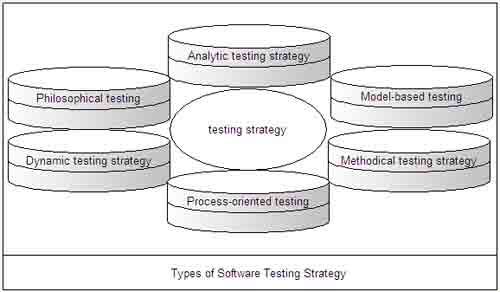To perform testing in a planned and systematic manner, software testing strategy is developed. A testing strategy is used to identify the levels of testing which are to be applied along with the methods, techniques, and tools to be used during testing. This strategy also decides test cases, test specifications, test case decisions, and puts them together for execution.
Developing a test strategy, which efficiently meets the requirements of an organization, is critical to the success of software development in that organization. Therefore, a software testing strategy should contain complete information about the procedure to perform testing and the purpose and requirements of testing.
The choice of software testing strategy is highly dependent on the nature of the developed software. For example, if the software is highly data intensive then a strategy that checks structures and values properly to ensure that all inputs given to the software are correct and complete should be developed. Similarly, if it is transaction intensive then the strategy should be such that it is able to check the flow of all the transactions. The design and architecture of the software are also useful in choosing testing strategy. A number of software testing strategies are developed in the testing process. All these strategies provide the tester a template, which is used for testing. Generally, all testing strategies have following characteristics.
- Testing proceeds in an outward manner. It starts from testing the individual units, progresses to integrating these units, and finally, moves to system testing.
- Testing techniques used during different phases of software development are different.
- Testing is conducted by the software developer and by an ITG.
- Testing and debugging should not be used synonymously. However, any testing strategy must accommodate debugging with itself.
Types of Software Testing Strategies
There are different types of software testing strategies, which are selected by the testers depending upon the nature and size of the software. The commonly used software testing strategies are listed below.

- Analytic testing strategy: This uses formal and informal techniques to access and prioritize risks that arise during software testing. It takes a complete overview of requirements, design, and implementation of objects to determine the motive of testing. In addition, it gathers complete information about the software, targets to be achieved, and the data required for testing the software.
- Model-based testing strategy: This strategy tests the functionality of the software according to the real world scenario (like software functioning in an organization). It recognizes the domain of data and selects suitable test cases according to the probability of errors in that domain.
- Methodical testing strategy: It tests the functions and status of software according to the checklist, which is based on user requirements. This strategy is also used to test the functionality, reliability, usability, and performance of the software.
- Process-oriented testing strategy: It tests the software according to already existing standards such as the IEEE standards. In addition, it checks the functionality of the software by using automated testing tools.
- Dynamic testing strategy: This tests the software after having a collective decision of the testing team. Along with testing, this strategy provides information about the software such as test cases used for testing the errors present in it.
- Philosophical testing strategy: It tests the software assuming that any component of the software can stop functioning anytime. It takes help from software developers, users and systems analysts to test the software.
A testing strategy should be developed with the intent to provide the most effective and efficient way of testing the software. While developing a testing strategy, some questions arise such as: when and what type of testing is to be done? What are the objectives of testing? Who is responsible for performing testing? What outputs are produced as a result of testing? The inputs that should be available while developing a testing strategy are listed below.
- Type of development project
- Complete information about the hardware and software components that are required to develop the software
- Risks involved
- Description of the resources that are required for testing
- Description of all testing methods that are required to test various phases of SDLC
- Details of all the attributes that the software is unable to provide. For example, software cannot describe its own limitations.
The output produced by the software testing strategy includes a detailed document, which indicates the entire test plan including all test cases used during the testing phase. A testing strategy also specifies a list of testing issues that need to be resolved.
An efficient software testing strategy includes two types of tests, namely, low-level tests and high-level tests. Low-level tests ensure correct implementation of small part of the source code and high-level tests ensure that major software functions are validated according to user requirements. A testing strategy sets certain milestones for the software such as final date for completion of testing and the date of delivering the software. These milestones are important when there is limited time to meet the deadline.
In spite of these advantages, there are certain issues that need to be addressed for successful implementation of software testing strategy. These issues are discussed here.
- In addition to detecting errors, a good testing strategy should also assess portability and usability of the software.
- It should use quantifiable manner to specify software requirements such as outputs expected from software, test effectiveness, and mean time to failure which should be clearly stated in the test plan.
- It should improve testing method continuously to make it more effective.
- Test plans that support rapid cycle testing should be developed. The feedback from rapid cycle testing can be used to control the corresponding strategies.
- It should develop robust software, which is able to test itself using debugging techniques.
- It should conduct formal technical reviews to evaluate the test cases and test strategy. The formal technical reviews can detect errors and inconsistencies present in the testing process.
 Dinesh Thakur holds an B.C.A, MCDBA, MCSD certifications. Dinesh authors the hugely popular
Dinesh Thakur holds an B.C.A, MCDBA, MCSD certifications. Dinesh authors the hugely popular